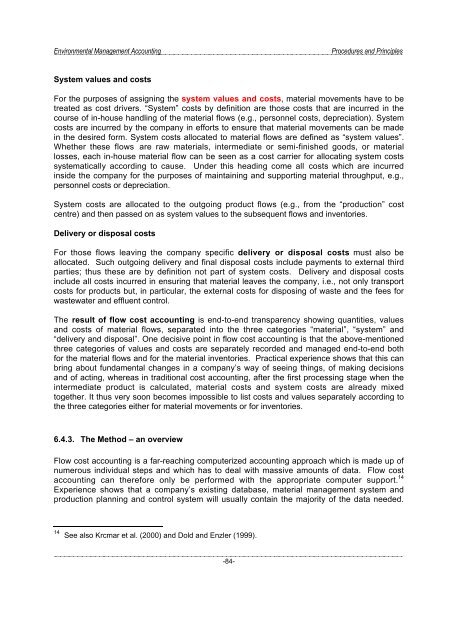Environmental Management Accounting Procedures and Principles
Environmental Management Accounting Procedures and Principles
Environmental Management Accounting Procedures and Principles
You also want an ePaper? Increase the reach of your titles
YUMPU automatically turns print PDFs into web optimized ePapers that Google loves.
<strong>Environmental</strong> <strong>Management</strong> <strong>Accounting</strong><br />
<strong>Procedures</strong> <strong>and</strong> <strong>Principles</strong><br />
System values <strong>and</strong> costs<br />
For the purposes of assigning the system values <strong>and</strong> costs, material movements have to be<br />
treated as cost drivers. “System” costs by definition are those costs that are incurred in the<br />
course of in-house h<strong>and</strong>ling of the material flows (e.g., personnel costs, depreciation). System<br />
costs are incurred by the company in efforts to ensure that material movements can be made<br />
in the desired form. System costs allocated to material flows are defined as “system values”.<br />
Whether these flows are raw materials, intermediate or semi-finished goods, or material<br />
losses, each in-house material flow can be seen as a cost carrier for allocating system costs<br />
systematically according to cause. Under this heading come all costs which are incurred<br />
inside the company for the purposes of maintaining <strong>and</strong> supporting material throughput, e.g.,<br />
personnel costs or depreciation.<br />
System costs are allocated to the outgoing product flows (e.g., from the “production” cost<br />
centre) <strong>and</strong> then passed on as system values to the subsequent flows <strong>and</strong> inventories.<br />
Delivery or disposal costs<br />
For those flows leaving the company specific delivery or disposal costs must also be<br />
allocated. Such outgoing delivery <strong>and</strong> final disposal costs include payments to external third<br />
parties; thus these are by definition not part of system costs. Delivery <strong>and</strong> disposal costs<br />
include all costs incurred in ensuring that material leaves the company, i.e., not only transport<br />
costs for products but, in particular, the external costs for disposing of waste <strong>and</strong> the fees for<br />
wastewater <strong>and</strong> effluent control.<br />
The result of flow cost accounting is end-to-end transparency showing quantities, values<br />
<strong>and</strong> costs of material flows, separated into the three categories “material”, “system” <strong>and</strong><br />
“delivery <strong>and</strong> disposal”. One decisive point in flow cost accounting is that the above-mentioned<br />
three categories of values <strong>and</strong> costs are separately recorded <strong>and</strong> managed end-to-end both<br />
for the material flows <strong>and</strong> for the material inventories. Practical experience shows that this can<br />
bring about fundamental changes in a company’s way of seeing things, of making decisions<br />
<strong>and</strong> of acting, whereas in traditional cost accounting, after the first processing stage when the<br />
intermediate product is calculated, material costs <strong>and</strong> system costs are already mixed<br />
together. It thus very soon becomes impossible to list costs <strong>and</strong> values separately according to<br />
the three categories either for material movements or for inventories.<br />
6.4.3. The Method – an overview<br />
Flow cost accounting is a far-reaching computerized accounting approach which is made up of<br />
numerous individual steps <strong>and</strong> which has to deal with massive amounts of data. Flow cost<br />
accounting can therefore only be performed with the appropriate computer support. 14<br />
Experience shows that a company’s existing database, material management system <strong>and</strong><br />
production planning <strong>and</strong> control system will usually contain the majority of the data needed.<br />
14 See also Krcmar et al. (2000) <strong>and</strong> Dold <strong>and</strong> Enzler (1999).<br />
-84-




